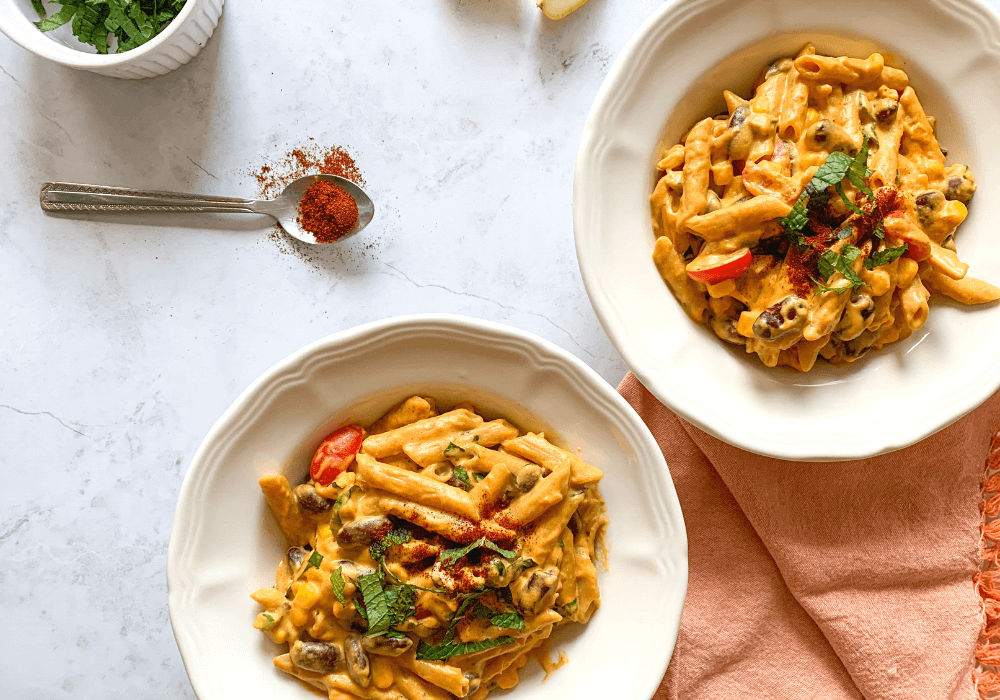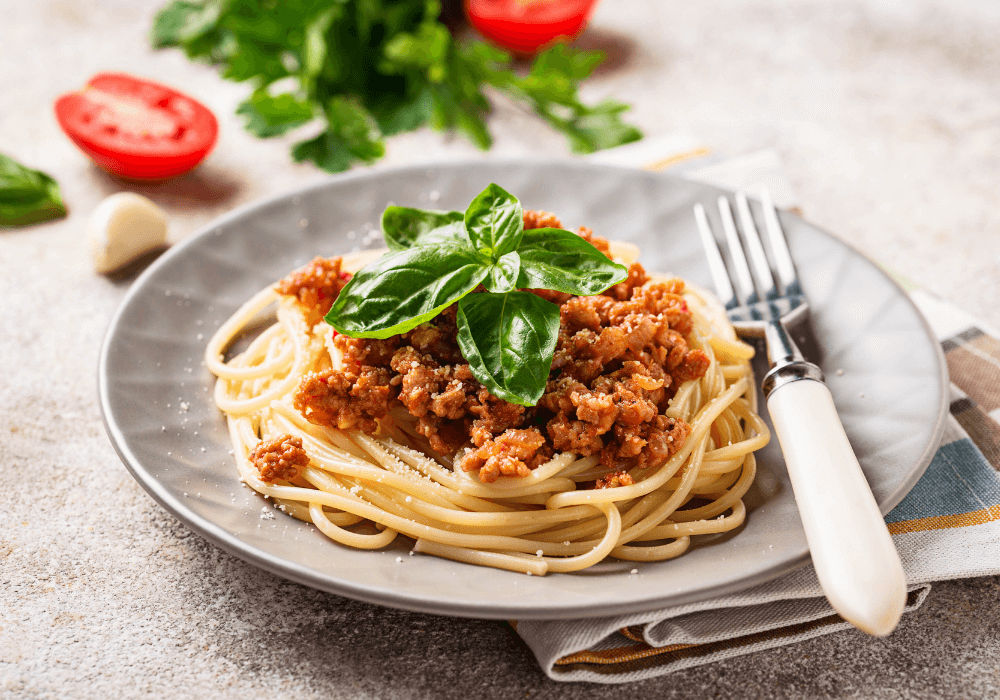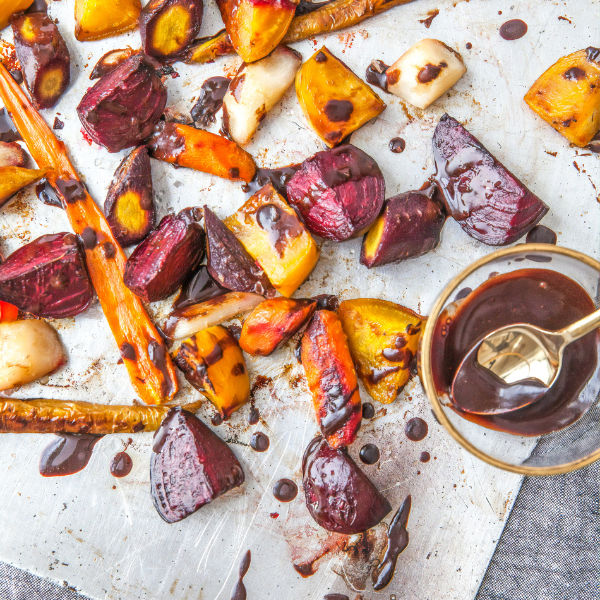Today we’re talking about the simplest way I know of to eat plant-based without actually changing your meals!
Now, I know this sounds impossible; I mean, how can you eat more plants if you don’t change what you’re eating?!
Hang with me for a sec and all shall be revealed!
The Simplest Step You Can Take To Eat More Plant-Based Meals
Completely overhauling your diet can be really overwhelming. So overwhelming, in fact, that a lot of people can’t get themselves to make all the changes “necessary” to eat a plant-based diet. So instead, they don’t take any steps or make any changes in their diet at all.
I know I’ve been here more than once and I bet you have too!
The good news is that it really doesn’t have to be this way!
Just as there are a myriad of ways to eat plant-based meals, there are equally as many ways to make the changes toward a whole food plant-based diet.

Today we’re talking about potentially the simplest, and, dare I say, least overwhelming way to change your diet and eat more whole plant foods.
I like to think of this method as the first step on the plant-based journey.
This is for you if you’re currently eating a standard omnivore diet containing animal products, processed foods, and plants.
So let’s get into the method!
The Method: Changing the Proportions on Your Plate
So, you want to eat more plants but aren’t sure where or how to start, right?
Should you go cold turkey and switch from a solid diet of meat and potatoes to green juice and avocado toasts overnight? Or what about jumping on one of the many “vegan in 7 days” challenges floating around the digital space. You know, those ones that promise total transformation and a completely new set of taste buds and cooking skills in a week?
Hmmm yeah, or maybe not.
Instead, let me suggest being gentle with yourself and your body. Give yourself time. For most people, that means don’t remove animal products or processed foods from your diet in one day, or one week.
Instead of going from meat and potatoes today to green juice and avocado toast tomorrow, work with what your current diet looks like.
Hear me out on this one.
Your current diet
Meal #1:
Maybe your current dinner consists of a big steak with crispy roasted potatoes and three or four tender asparagus on the side.
Meal #2:
Or maybe this sounds more like you: a bowl of spaghetti bolognese with a sprinkle of parmesan cheese and some chopped parsley on top.

Meal #3:
Or maybe rice is a staple in your diet and your meals tend to look something like this: a plate filled with white rice with a few dollops of lentil curry and a spoonful of spicy veggie stir fry.
You might be sitting there nodding along and wondering how the hell you’re going to take those meals and make them more plant-based. And don’t forget the part where I said you can do all this without changing what you’re eating (ie you can still eat your meat and potatoes dinner).
Now that we’re on the same page about what your current diet might look like, let’s see how we can easily add more plants to those meals.

Assessing your meals:
No matter which type of meal you currently eat, there are likely some kinds of whole plant foods already part of your plate.
In meal number one, the plants are the roasted potatoes and the asparagus. Maybe there’s some fresh parsley sprinkled on top of the steak too.
In the second meal, you’ve got the tomatoes in the sauce, as well as some onions, garlic, and herbs, plus the fresh herbs on top. Note that we’re focused on WHOLE plant foods here, so the typical spaghetti, which is made out of refined flour, is a processed food, not a whole plant food.
In meal three, there’s the lentils, spices, onion, garlic, and possibly tomatoes in the lentil curry, plus all the veggies in the stir fry. Here again, while this meal could be completely plant-based, the majority of the plate is filled with white rice, a processed food, not a whole food.
You can do this assessment with any meal, no matter what it is or how heavy on the animal products or processed foods it is. Even something as far from whole foods as a McDonald’s cheeseburger (almost completely meat, dairy, and ultra-refined bread) has some whole plant foods like tomato, lettuce, onions, etc.
Think of this as the first baby step toward eating more plants. To make that change, you first need to be aware of the whole plant foods you are eating in each meal.
Do you see where we’re going with this? Not yet? Keep reading. We’re almost there!
Moving toward more plant-based meals:
Now that you’ve assessed your current meal, it’s time to make it more plant-focused!
Step 1: Add More of What’s Already There
To do this, you’re going to focus on increasing the plants on your plate. As we already established, there are probably already some whole plant foods in your meals. So focus on those components of your plate and increase them. Increase their size and their abundance on your plate.
Let’s look at our example meals from earlier.
For the meat and potatoes dinner, we can do a few things:
- Add more roasted potatoes.
- Maybe there’s some rosemary on the potatoes. Consider adding more fresh herbs to your potatoes!
- You can also increase the number of asparagus on the side. Instead of eating three spears, put 8 or 10 on your plate!
With just a few tweaks, and not actually changing the meal, we’ve added a significant amount of more whole plant foods!
Let’s look at meal number two.
For the spaghetti bolognese bowl:
- Add more of the veggies already present in the sauce. You can also add other veggies like finely diced carrots and celery (often present in traditional Italian bolognese!).
- Increase the amount of fresh herbs on top of the spaghetti. I always say toppings are as important as the base of the meal and this is one of the reasons. You can add a significant amount of nutrition in the form of fresh herbs (ie whole plant foods!) just as a topping on your food!
Finally, let’s add some more plants to the rice plate.
This one is pretty straight forward:
- Add more of the lentil curry.
- Increase the one spoonful of veggies to three or four spoonfuls!
- Instead of a plate of mostly white rice with a few veggies and lentils, build a plate of a whole bunch of lentils and veggies with some white rice.
See what we did there? Instead of the meals we saw earlier, those plates look much more abundant with whole plant foods. And while they might not be what comes to mind when you think of plant-based meals, they’re moving you in that direction!

The great part about this method is called the “crowding out” effect. Since you can only eat the same amount of food as you were eating before, when you add more food to your plate (in the form of whole plants) another component of your meal will have to decrease.
This way, crowding out makes it easy to slowly increase your plant consumption and decrease your animal and processed food consumption.
Once you get comfortable with assessing your meals and increasing the proportion of plants to animal or processed foods on your plate, you can take it one step further!
Step 2: Add More Plants
Now that you’ve got the hang of the crowding out method, you can start actively adding more whole plant foods to your meals!
Before you start thinking this sounds like a big task and get overwhelmed on me, let’s look at our three example meals and see how to do this.
In the meat and potatoes meal, we’ve now got a lot of asparagus and roasted potatoes, with a medium size steak.
Here are a few ideas to easily make this meal more plant-based:
- Roast some other veggies along with the potatoes like cauliflower, fennel, and beets. Each time you make this meal, try switching up the veggies you roast.
- Make a homemade chimichurri sauce to top the steak (or drench the entire plate in it as I do). Herb-based dips and sauces like chimichurri and pesto are an amazing and easy way of adding a whole lotta plants (and some serious flavor) while sticking to the original meal concept.
For the spaghetti bowl, we’ve also got options:
- Add extra veggies to the sauce. This is pretty unlimited and fool-proof. Try diced zucchini, bell pepper, or mushrooms, or wilt in some spinach, kale, or swiss chard.
- Add some lentils in with the ground meat as you make the bolognese sauce. Try using half ground meat and half lentils instead of all ground meat.
- Swap the traditional white pasta for whole wheat or another whole grain pasta. This is a super easy swap that you can make with all your pasta dishes and instantly adds a whole plant food to your meal!
Let’s take a look at the rice and lentil plate:
- Lentil curries like this one are often just lentils, onions, garlic, maybe some tomatoes, and a whole lot of spices. For dishes like this, try adding more veggies! Diced zucchini again works great here, as do any chopped wilted greens. But so do small cauliflower florets, cubed carrots, or even some diced sweet potato!
See how easy and non-overwhelming that was? You’ve now gone from eating a big piece of meat with a few bites of veggies to a whole lotta veggies and a few bites of meat! That’s how you make plant-based meals feel doable and familiar.
Pssst: if you want to take this process even further, try swapping out some of the animal products on your plate. You can sub plant-based versions in their place. Check out this blog post I wrote about this exact topic.
I know this was a long blog post, but I hope it’s been a super useful one! My goal, as always, is to help you put more whole plants on your plate.
Changing the way you think about your meals and realizing each meal is made up of various components whose proportions can be shifted around is SUPER POWERFUL!
So go out there, change up the proportions on your plate, and create more plant-based meals!
As you dive into this process, I’m here for you every step of the way! Let’s chat in the comments, or connect with @plantssogood on Instagram or Facebook!




Leave a Reply